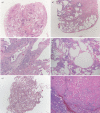Lung complications of Sjogren syndrome
- PMID: 32817113
- PMCID: PMC9489025
- DOI: 10.1183/16000617.0021-2020
Lung complications of Sjogren syndrome
Abstract
Primary Sjogren syndrome (pSS) is a systemic autoimmune disease characterised by lymphocytic infiltration of exocrine glands and by a number of systemic manifestations, including those regarding the lung. Pulmonary involvement in pSS includes interstitial lung disease (ILD) and airway disease, together with lymphoproliferative disorders.Patients with pSS-ILD report impaired health-related quality of life and a higher risk of death, suggesting the importance of early diagnosis and treatment of this type of pulmonary involvement. In contrast, airway disease usually has little effect on respiratory function and is rarely the cause of death in these patients.More rare disorders can be also identified, such as pleural effusion, cysts or bullae.Up to date, available data do not allow us to establish an evidence-based treatment strategy in pSS-ILD. No data are available regarding which patients should be treated, the timing to start therapy and better therapeutic options. The lack of knowledge about the natural history and prognosis of pSS-ILD is the main limitation to the development of clinical trials or shared recommendations on this topic. However, a recent trial showed the efficacy of the antifibrotic drug nintedanib in slowing progression of various ILDs, including those in pSS patients.
Copyright ©ERS 2020.
Conflict of interest statement
Conflict of interest: F. Luppi reports personal fees from Roche and Boheringer-Ingelheim, outside the submitted work. Conflict of interest: M. Sebastiani has nothing to disclose. Conflict of interest: N. Sverzellati has nothing to disclose. Conflict of interest: A. Cavazza has nothing to disclose. Conflict of interest: C. Salvarani has nothing to disclose. Conflict of interest: A. Manfredi has nothing to disclose.
Figures




References
Publication types
MeSH terms
LinkOut - more resources
Full Text Sources
Medical
